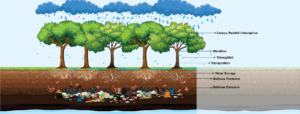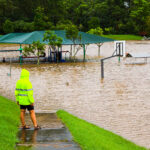What is Phytocapping?
Phytocapping is a capping technique that utilises vegetation as a natural pumping system to reduce water being stored in the soil and percolate into the covered waste. This in turn reduces the amount of water interacting with the buried waste and generating leachate.
The Legislation
In accordance with relevant State and Territory Guidelines, all completed landfill cells must be capped and revegetated as soon as practicable once the final waste profile is achieved. Phytocapping is an alternative option to traditional clay or geosynthetic capping methods for closed landfills with the intention towards effective leachate management and containment of environmental pollution.
How does it work?
Vegetation extract water through the soil that they grow in for their development. The key process that uses this water is photosynthesis. Excess water that is not used in this process is released into the atmosphere through transpiration through the leaf surface. Some water received via rainfall is also stored in the canopy and directly evaporated into the atmosphere without reaching the ground. Vegetation that has a high capacity for respiration through photosynthesis is highly suitable for phytocapping.

What are the benefits of Phytocapping?
There are economic, environmental and social benefits to phytocapping. Establishing and managing a vegetative cap cost less overall than delivery and management of traditional clay-based cap where availability of suitable clay material is sparse. Cost savings have shown that as we move away from a traditional cap, spend per metre is approximately halved if planned ahead.
Increased vegetation provides habitat for a variety of fauna species and can often provide key linkages within the landscape. Phytocaps are most beneficial where the potential evapotranspiration rate exceeds the average rainfall.
Phytocapping can provide social benefits if recreational aspects can be built into the redevelopment of the site. This is particularly applicable in urban areas, with land previously unusable for recreational benefits becomes newly available.
How do we monitor a phytocap to ensure its efficiency
Phytocaps have been successfully constructed/established across a number of closed landfills in Australia. Ultimately, phytocapping reduces the cost of ongoing capping for the life of the closed landfills. Type 2 landfills require lysimeter monitoring to determine the effectiveness of the cap. There are 3 elements of the phytocap that will influence the long-term effectiveness of the capping system. Climate, soil type and vegetation are critical for water balance and management within the site.
Design Process
Pre-qualification tests and modelling needs to be undertaken to determine the suitability of a phytocap for the site. The design can factor in post-closure recreational aspects to promote additional use of the site, particularly those closer to developed areas. A pre-qualification test will require determination of the source of local soil, its physical and hydraulic properties and prediction of the hydrological balance using mathematical models such as HELP, HYDRUS, LEACHM etc.
Key Considerations of Design
Vegetation used in the phytocap should be selected with preference to faster growing species that have high stomata to leaf area ratio. Local climate factors are also critical for plant selection, given colder climate species will not be adapted to higher temperatures and vice versa. Being able to manage threats to the revegetation are an important consideration. Competition from weeds, watering through drought periods and limiting impacts from browsing by fauna need to be integrated into the overall design of the area.
Monitoring
Monitoring is an essential activity to collate data relating to the effectiveness of a phytocap. Establishment of a lysimeter will assist in monitoring the water balance of the site through an indicative measurement of net percolation. Data on height and stem diameter of established plants will assist in measuring effectiveness of selected species over others in consideration with climatic factors. This will influence species selection for other phytocaps within the local area, if required.
Maintenance
Maintenance costs will be higher in the first few years of a phytocap but will decrease over time as the natural system establishes and aspects of ecosystem function recover. It is important to monitor development of the trees and comparable weed growth in the initial stages as competition between the two could be a limiting factor in growth. Regular inspections will also assist in recognising other limiting factors such as drought stress, nutrient deficiency and impacts from browsing or illegal timber harvesting.




